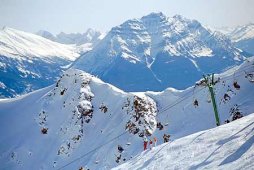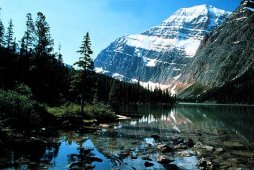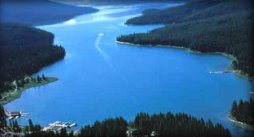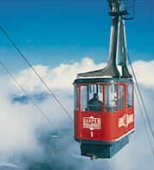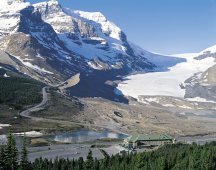
|
|||||||||||

|
|||||||||||
Jasper National Park, Alberta, Canada
|

|
||||||||||
Jasper in Figures Jasper is a small community of 4700 people. Many of the mountains rise to elevations above 3000 metres. Mt. Columbia, the highest peak in Alberta, is 3782 metres. The lowest point in the park, 985 metres above sea level, lies near the park's east gate. The Canadian Rockies are known to support 1300 species of plants, 20,000 types of insects and spiders, 40 types of fish, 16 species of amphibians and reptiles, 277 species of birds and 69 different species of mammals. Arrival The Trans-Canada Highway #16 (also called the Yellowhead Highway) runs through the park and is the main route to and from Jasper. The Icefields Parkway connects Jasper with the Trans-Canada Highway #1 near Lake Louise and Banff. If you prefer going by train, Via Rail has regular train service to Jasper via Edmonton and Vancouver. Individual travellers can take the Greyhound Bus from either Vancouver or Edmonton to Jasper. Distances: Edmonton - Jasper National Park 370 km (192 mi) Calgary - Jasper National Park 404 km (256 mi) Vancouver - Jasper National Park 805 km (500 mi) Points of Interest in Jasper Maligne Lake
Maligne Canyon One of the most spectacular gorges in the Canadian Rockies, sheer limestone walls plunge to depths of over 50 metres (165 feet). In summer, an interpretive trail winds its way from a picnic area across six bridges where you can catch the spray from thundering Maligne River, or peer into the mossy depths. Watch out for the birds that breed in the walls. In wintertime try your hand at a guided Canyon tour across the floor of the frozen canyon. The frozen beauty of waterfalls such as Angel Falls and Queen of Maligne is simply breathtaking. Winter turns their cascades into delicate sculptures beyond any human artisan's skill. Medicine Lake This intriguing lake is a place of mystery and Indian legends. Medicine Lake is drained by one of the largest underground river systems in North America. The water level of the lake varies from season to season. Sometimes it even disappears...! Indians once thought that "spirits" were responsible for the dramatic fluctuations in the placid waters. Watch out for the interpretive signs along the trail. Jasper Miette Hot Springs  The Canadian Rockies Hot Springs invite you to relax in a spectacular mountain setting and soak in hot mineral waters that have rejuvenated travellers for more than a century. The drive up the wild Fiddle Valley to the hottest mineral springs in the Rockies is truly marvellous. Flowing from the mountain at 54 degree C (129 degree Fahrenheit), the water is cooled to a comfortable temperature of 40 degree C (102 degree Fahrenheit) as it enters the pools. The facility includes two hot pools (one pool is wheel chair accessible), a cool pool and poolside cafe. Nearby hiking trails and picnic sites make Miette Hot Springs a perfect destination. Excellent wildlife viewing opportunities on the way- see bighorn sheep, black bear and deer.
Highway 93 (Icefields Parkway) Athabasca Falls Among the most breathtaking and powerful falls in the Canadian Rocky Mountains, the Athabasca River thunders through a narrow gorge where the walls have been smoothed and potholed by the sheer force of the rushing waters that carry sand and rocks. A bridge and a platform give views of the thundering falls. Columbia Icefields
Marmot Basin Marmot Basin provides 75 named trails on over 1,500 acres of terrain supported by world-class facilities. The mountain offers 3,000 vertical feet of skiing and snowboarding on 100% natural, dry, Rocky Mountain powder. The ski area's modern lift system carries 11,931 skiers uphill per hour and Marmot Basin is one of the least crowded ski areas of its size in all of North America. From long, gentle, winding novice runs, to steep, high alpine bowls and chutes, skiers and snowboarders of all abilities will find what they are looking for at Marmot Basin. Fabulous views and great skiing will ensure a fantastic day of skiing! Highway 93A Mount Edith Cavell Few summits in the park can match Mount Edith Cavell's craggy beauty. A small, powder blue meltwater lake and beautiful Angel Glacier are easily reached by a short self -guiding trail that winds its way along the shores of the lake. Another longer trail leads to Cavell Meadows. Trails are less crowded mornings or late afternoons. Jasper Yellowhead Museum The Jasper Yellowhead Museum collects and preserves exhibition documents and artifacts, which illustrate the history of humans of Jasper National Park and the Yellowhead corridor. The Archives' features 400 books, diaries, literary manuscripts, memoirs and much more. Thousands of negatives, prints, albums and transparencies are kept in the museum. As well it features more than 50 cassette tapes, some of which are significant oral histories. The Jasper Information Centre The Jasper Information Centre a truly historic site, was build in 1914, and is located on the main road. It was used to house the park superintendent and the park administration offices, and has always been a focus point for the tourists. In the past it also housed a fish hatchery and a Library. The house was build out of rocks and local logs to suit the setting, it became a model of rustic design for other national parks. Jasper Park was named after a fur trading post in the area called Jasper House, which was named after Jasper Hawse, who managed this post in the early 1800s. This Travel Guide was kindly made available by Elke Vogelpohl of Mica Mountain Lodge in Tete Jaune Cache. 
|
|||||||||||
More Travel Tips
|
|||||||||||
